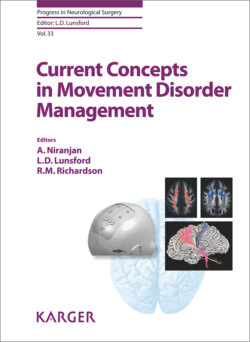Читать книгу Current Concepts in Movement Disorder Management - Группа авторов - Страница 53
Tics and Tourette Syndrome
ОглавлениеTics are characterized as brief repetitive movements (motor tics) or sounds (vocal/phonic tics) that are usually preceded by a premonitory urge or sensation and are partially suppressible, hence their designation as semi-voluntary. Tics may be transient or chronic, differentiated by duration of 1 year. Transient tic disorder is the most common form of tics in children. There is a wide variety of tic phenomenology and they are divided into simple or complex movements. Examples of simple motor tics include blinking, head jerking, facial grimacing, and shoulder shrugging. Complex motor tics involve coordinated sequences of movements that resemble normal motor activities, such as kicking, touching, and making obscene gestures. Examples of simple phonic tics include throat clearing, sniffing, coughing, and grunting, while complex phonic tics include meaningful verbalizations, such as yelling of profanities (coprolalia) or repeating the last words or phrase uttered (palilalia). Tics have variable functional impact, and when severe may cause limitations in social or professional development. In some cases, motor tics may be so forceful as to cause physical injury.
Tourette syndrome (TS) is the most common cause of tics, and the diagnostic criteria requires the presence of multiple motor tics and at least one phonic tic, not necessarily concurrently, persisting for at least 1 year with onset before age 18. The prevalence of TS is estimated to be 0.77% in children (much higher in boys than girls) and 0.05% in adults [22]. In most cases, onset of tics occurs between ages 5 and 8 and progressively increases in severity, peaking between ages 10 and 12 followed by steady decline [22]. Tics typically occur in a waxing and waning course, with tic-free periods of varying intervals, and exacerbations during times of high anxiety, stress or fatigue. Tics may also change in phenomenology over time. In about half of patients with TS, tics resolve in adulthood. Improvement is seen in most of the remaining, with a small minority persisting unchanged. Higher tic severity during childhood is associated with increased tic severity in adulthood. The majority of adult onset TS seems to represent re-emergence or exacerbation of childhood-onset TS, although a minority of patients do report new occurrence of tics after age 18 [23].
TS is strongly associated with a spectrum of psychiatric comorbidities, most notably attention deficit, hyperactivity disorders, and obsessive compulsive disorder (OCD). In a recent large study of TS, the lifetime prevalence of having at least one comorbid psychiatric disorder was 85.7%, with 72.1% meeting criteria for either OCD or attention deficit and hyperactivity disorders [24]. Other mood and behavioral disturbances are common and include impulsivity, depression, anxiety, anger control problems, and self-injurious behavior.
Tics may occur secondary to genetic conditions (Huntington disease, neuroacanthocytosis, pantothenate kinase-associated neurodegeneration), drugs (cocaine, levodopa), encephalitis, toxins, structural brain lesions such as stroke and tumor, and peripheral trauma. Clinical features of secondary tics are no different than primary tic disorders, although the premonitory sensory phenomena occur less frequently.
Treatment for TS is guided by functional impact and individualized to encompass psychiatric comorbidities. Treatment typically begins with behavioral therapy, with benefit demonstrated in multiple randomized controlled trials. In milder cases, this may be sufficient. When pharmacologic therapy is warranted, neuroleptics are the most effective class of medications but are accompanied by a substantial side effect profile. Typical antipsychotics such as haloperidol and pimozide have the most data to support their use, but atypical antipsychotics such as risperidone and aripiprazole have been gaining favor due to better tolerability and comparable efficacy. Central alpha-2 agonists such as clonidine and guanfacine have a long history of use in tic disorders and are frequently chosen in the pediatric population as first line therapies. The dopamine depleter, tetrabenazine, is a potent treatment for tics and has minimal potential for causing tardive syndromes. Other pharmacologic options with limited data on efficacy in tics include clonazepam, levetiracetam, topiramate, magnesium, and dronabinol. Botulinum toxin injections into the affected muscles have had reported success in both motor and phonic tics in multiple case series and one randomized controlled trial [25].
Table 2. Summary of clinical features and management of common movement disorders
Surgical treatments have been performed in severe cases of TS since the 1970s. Ablative procedures, usually targeting the thalamus, have been associated with substantial adverse effects and are generally no longer pursued. DBS has been increasingly investigated, with encouraging results showing reduction in tic severity scales and improvement in quality of life measures. However, the evidence has been mainly from case reports and small case series. At this time, DBS remains investigational and is thus reserved for the most severely disabling tics and medication refractory cases. The optimal target is yet to be determined. The medial thalamus (centromedian nucleus-para fascicular complex) and GPi are most commonly used targets, but the nucleus accumbens, anterior limb of the internal capsule, subthalamic nucleus, and globus pallidus externa have also been reported to have favorable outcomes. Effect on psychiatric comorbidities including OCD, anxiety, and mood disorders are inconsistent, with improvement seen in some cases, while in others it remains unchanged.
